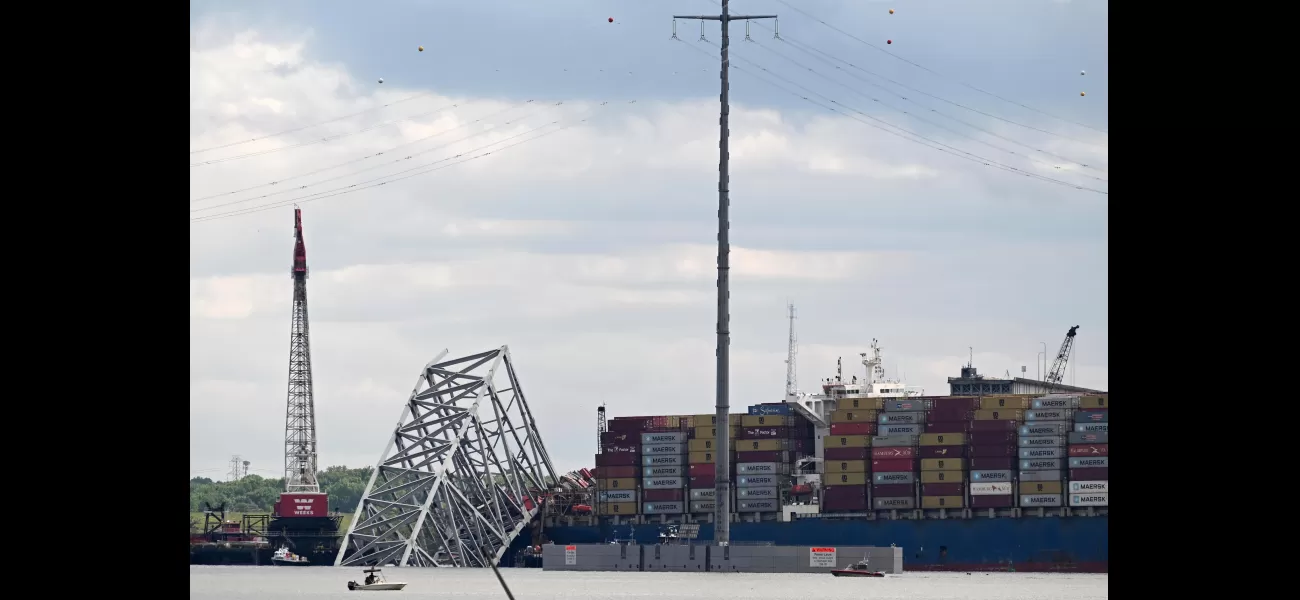A cargo ship, which left port hours after experiencing a power outage, is responsible for the collapse of a Baltimore bridge.
Report on Key Bridge collapse reveals cargo ship Dali had power outage during maintenance before leaving Baltimore.
May 15th 2024.

BALTIMORE — The recent tragedy involving the cargo ship Dali has been further investigated by federal investigators, who shared their findings on Tuesday. The ship, which was carrying shipping containers and supplies for a monthlong voyage from Baltimore to Sri Lanka, experienced multiple electrical blackouts before crashing into the Francis Key Bridge and causing the death of six construction workers. The National Transportation Safety Board provided a detailed account of the events leading up to the tragedy, shedding light on the series of power outages that occurred while the ship was still docked in Baltimore.
According to the preliminary report, the first blackout occurred when a crew member accidentally closed an exhaust damper during maintenance, causing one of the ship's diesel engines to stall. This was followed by a second outage shortly after the ship departed from Baltimore, which led to a loss of steering and propulsion at a critical moment, resulting in the collision with the bridge. The report also mentioned that the ship's fuel did not show any signs of contamination, ruling out any concerns related to its quality.
Further investigation into the power issues revealed that after the initial blackout, a backup generator kicked in but eventually shut off due to insufficient fuel pressure. In an attempt to address the problem, the crew made changes to the ship's electrical configuration, switching to a different transformer and breaker system before departing. However, investigators did not directly link these power issues to the blackout that caused the bridge collapse.
The safety board, whose mission is to prevent such incidents from recurring, launched their investigation immediately after the collapse. They collected evidence and interviewed the captain and crew members. The report also detailed the chaotic moments leading up to the disaster, as the crew tried to restore power while the ship was just half a mile away from the bridge.
As the ship lost power, the pilots called for tugboats to assist in guiding it. However, the tugboats had already left, following standard procedure. The crew also dropped anchor and called for help, with the pilots' dispatcher notifying the authorities. Despite their efforts, the ship experienced another blackout, too late to avoid the collision. The pilots tried to turn the rudder, but with no propulsion, they were unable to steer the ship away from the bridge. A mayday call was made, allowing the police to stop traffic to the bridge.
At 1:29 a.m., the steel span of the bridge collapsed into the Patapsco River, resulting in the death of six construction workers who were on their break. One crew member managed to free himself from his work truck and was later rescued from the water. Another worker survived by running to safety before the bridge fell.
Recently, a controlled demolition was conducted to remove the largest remaining span of the collapsed bridge, which was pinning the Dali to the wreckage. The ship is expected to be refloated and returned to the Port of Baltimore. The preliminary report also mentioned that the ship had made stops at other ports before the accident, but no other power outages were reported.
The safety board is working with the manufacturer of the ship's electrical system to determine the cause of the tripped breakers and subsequent blackouts. However, their final report, which is expected to take more than a year, will likely include more in-depth findings. The FBI has also launched a criminal investigation into the events that led to the collapse.
According to the preliminary report, the first blackout occurred when a crew member accidentally closed an exhaust damper during maintenance, causing one of the ship's diesel engines to stall. This was followed by a second outage shortly after the ship departed from Baltimore, which led to a loss of steering and propulsion at a critical moment, resulting in the collision with the bridge. The report also mentioned that the ship's fuel did not show any signs of contamination, ruling out any concerns related to its quality.
Further investigation into the power issues revealed that after the initial blackout, a backup generator kicked in but eventually shut off due to insufficient fuel pressure. In an attempt to address the problem, the crew made changes to the ship's electrical configuration, switching to a different transformer and breaker system before departing. However, investigators did not directly link these power issues to the blackout that caused the bridge collapse.
The safety board, whose mission is to prevent such incidents from recurring, launched their investigation immediately after the collapse. They collected evidence and interviewed the captain and crew members. The report also detailed the chaotic moments leading up to the disaster, as the crew tried to restore power while the ship was just half a mile away from the bridge.
As the ship lost power, the pilots called for tugboats to assist in guiding it. However, the tugboats had already left, following standard procedure. The crew also dropped anchor and called for help, with the pilots' dispatcher notifying the authorities. Despite their efforts, the ship experienced another blackout, too late to avoid the collision. The pilots tried to turn the rudder, but with no propulsion, they were unable to steer the ship away from the bridge. A mayday call was made, allowing the police to stop traffic to the bridge.
At 1:29 a.m., the steel span of the bridge collapsed into the Patapsco River, resulting in the death of six construction workers who were on their break. One crew member managed to free himself from his work truck and was later rescued from the water. Another worker survived by running to safety before the bridge fell.
Recently, a controlled demolition was conducted to remove the largest remaining span of the collapsed bridge, which was pinning the Dali to the wreckage. The ship is expected to be refloated and returned to the Port of Baltimore. The preliminary report also mentioned that the ship had made stops at other ports before the accident, but no other power outages were reported.
The safety board is working with the manufacturer of the ship's electrical system to determine the cause of the tripped breakers and subsequent blackouts. However, their final report, which is expected to take more than a year, will likely include more in-depth findings. The FBI has also launched a criminal investigation into the events that led to the collapse.
[This article has been trending online recently and has been generated with AI. Your feed is customized.]
[Generative AI is experimental.]
0
0
Submit Comment





